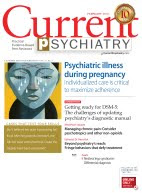Helen M. Farrell, MD
Dr. Farrell is an instructor at Harvard Medical School and a staff psychiatrist at Beth Israel Deaconess Medical Center, Boston, MA
Douglas Mossman, MD
Dr. Mossman is administrative director, Glenn M. Weaver Institute of Law and Psychiatry, University of Cincinnati College of Law, and Adjunct Professor of Clinical Psychiatry and Training Director for the University of Cincinnati Forensic Psychiatry Fellowship, Cincinnati, OH
Dear Dr. Mossman:
I practice in a region with few psychiatrists and very little public transportation. For many patients, coming to my office is inconvenient, expensive, or time-consuming. Sometimes, their emotional problems make it hard for them to travel, and sometimes, bad weather makes travel difficult. I am considering providing remote treatment via Skype. Is this a reasonable idea? What are the risks of using this technology in my practice?—Submitted by “Dr. A”
Diagnosing and treating patients without a face-to-face encounter is not new. Doctors have provided “remote treatment” since shortly after telephones were invented. Until recently, however, forensic psychiatrists advised colleagues not to diagnose patients or start treatment based on phone contact alone.
The Internet has revolutionized our attitudes about many things. Communication technologies that seemed miraculous a generation ago have become commonplace and have transformed standards for ordinary and “acceptable” human contact. A quick Internet search of “telephone psychotherapy” turns up hundreds of mental health professionals who offer remote treatment services to patients via computers and Web cams.
Physicians in many specialties practice telemedicine, often with the support and encouragement of state governments and third-party payers. To decide whether to include telepsychiatry in your psychiatric practice, you should know:
what “telemedicine” means and includes
the possible advantages of offering remote health care
potential risks and ambiguity about legal matters.


